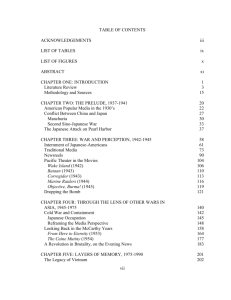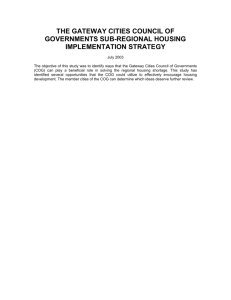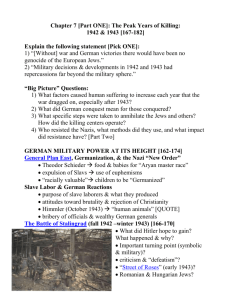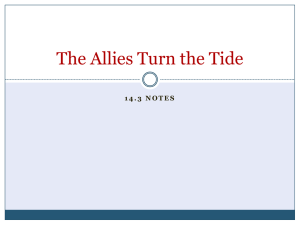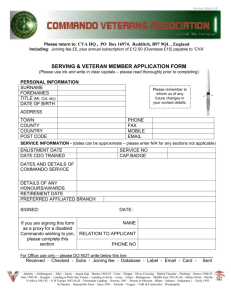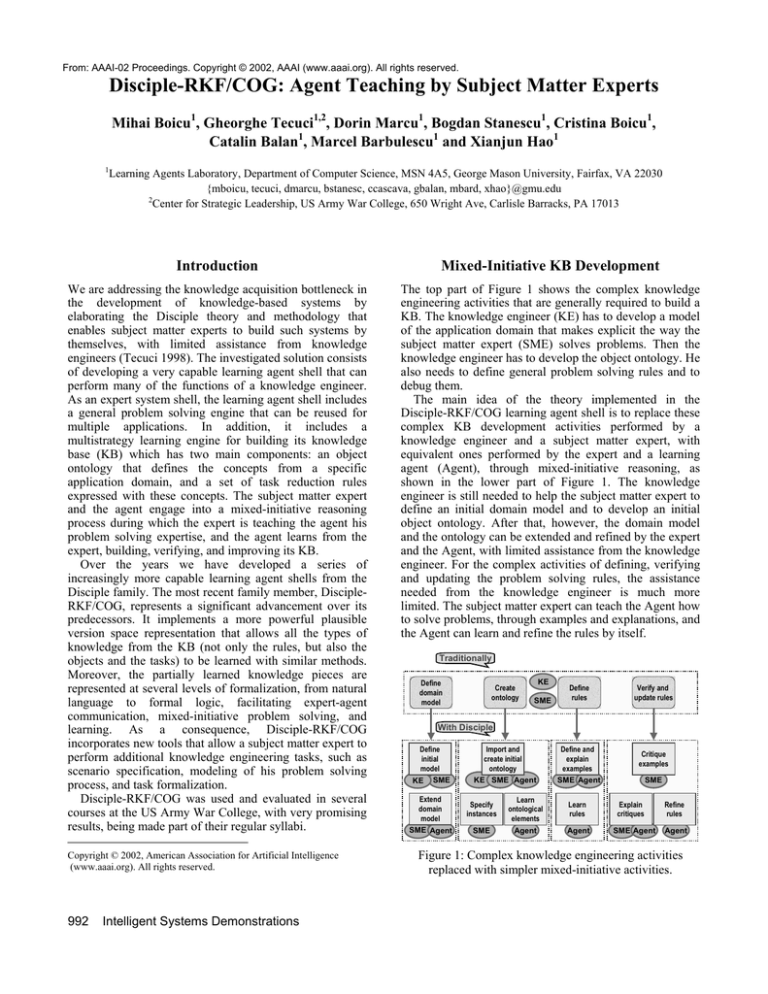
From: AAAI-02 Proceedings. Copyright © 2002, AAAI (www.aaai.org). All rights reserved.
Disciple-RKF/COG: Agent Teaching by Subject Matter Experts
Mihai Boicu1, Gheorghe Tecuci1,2, Dorin Marcu1, Bogdan Stanescu1, Cristina Boicu1,
Catalin Balan1, Marcel Barbulescu1 and Xianjun Hao1
1
Learning Agents Laboratory, Department of Computer Science, MSN 4A5, George Mason University, Fairfax, VA 22030
{mboicu, tecuci, dmarcu, bstanesc, ccascava, gbalan, mbard, xhao}@gmu.edu
2
Center for Strategic Leadership, US Army War College, 650 Wright Ave, Carlisle Barracks, PA 17013
Introduction
Mixed-Initiative KB Development
We are addressing the knowledge acquisition bottleneck in
the development of knowledge-based systems by
elaborating the Disciple theory and methodology that
enables subject matter experts to build such systems by
themselves, with limited assistance from knowledge
engineers (Tecuci 1998). The investigated solution consists
of developing a very capable learning agent shell that can
perform many of the functions of a knowledge engineer.
As an expert system shell, the learning agent shell includes
a general problem solving engine that can be reused for
multiple applications. In addition, it includes a
multistrategy learning engine for building its knowledge
base (KB) which has two main components: an object
ontology that defines the concepts from a specific
application domain, and a set of task reduction rules
expressed with these concepts. The subject matter expert
and the agent engage into a mixed-initiative reasoning
process during which the expert is teaching the agent his
problem solving expertise, and the agent learns from the
expert, building, verifying, and improving its KB.
Over the years we have developed a series of
increasingly more capable learning agent shells from the
Disciple family. The most recent family member, DiscipleRKF/COG, represents a significant advancement over its
predecessors. It implements a more powerful plausible
version space representation that allows all the types of
knowledge from the KB (not only the rules, but also the
objects and the tasks) to be learned with similar methods.
Moreover, the partially learned knowledge pieces are
represented at several levels of formalization, from natural
language to formal logic, facilitating expert-agent
communication, mixed-initiative problem solving, and
learning. As a consequence, Disciple-RKF/COG
incorporates new tools that allow a subject matter expert to
perform additional knowledge engineering tasks, such as
scenario specification, modeling of his problem solving
process, and task formalization.
Disciple-RKF/COG was used and evaluated in several
courses at the US Army War College, with very promising
results, being made part of their regular syllabi.
The top part of Figure 1 shows the complex knowledge
engineering activities that are generally required to build a
KB. The knowledge engineer (KE) has to develop a model
of the application domain that makes explicit the way the
subject matter expert (SME) solves problems. Then the
knowledge engineer has to develop the object ontology. He
also needs to define general problem solving rules and to
debug them.
The main idea of the theory implemented in the
Disciple-RKF/COG learning agent shell is to replace these
complex KB development activities performed by a
knowledge engineer and a subject matter expert, with
equivalent ones performed by the expert and a learning
agent (Agent), through mixed-initiative reasoning, as
shown in the lower part of Figure 1. The knowledge
engineer is still needed to help the subject matter expert to
define an initial domain model and to develop an initial
object ontology. After that, however, the domain model
and the ontology can be extended and refined by the expert
and the Agent, with limited assistance from the knowledge
engineer. For the complex activities of defining, verifying
and updating the problem solving rules, the assistance
needed from the knowledge engineer is much more
limited. The subject matter expert can teach the Agent how
to solve problems, through examples and explanations, and
the Agent can learn and refine the rules by itself.
Copyright © 2002, American Association for Artificial Intelligence
(www.aaai.org). All rights reserved.
992
Intelligent Systems Demonstrations
Traditionally
Define
domain
model
Create
ontology
KE
SME
Define
rules
Verify and
update rules
With Disciple
Define
initial
model
KE SME
Extend
domain
model
SME Agent
Import and
create initial
ontology
KE SME Agent
Specify
instances
SME
Learn
ontological
elements
Agent
Define and
explain
examples
SME Agent
Learn
rules
Agent
Critique
examples
SME
Explain
critiques
SME Agent
Refine
rules
Agent
Figure 1: Complex knowledge engineering activities
replaced with simpler mixed-initiative activities.
Disciple teaching by a subject matter expert
Final remarks
An important feature of the Disciple agent development
approach is that it distinguishes very clearly the phases
where the knowledge engineer plays a critical role, from
those that are primarily performed by the subject matter
expert.
First, the knowledge engineer has to work with the
subject matter expert to develop an initial model of how
the expert solves problems, based on the task reduction
paradigm. This model identifies also the object concepts
that need to be present in Disciple’s ontology so that it can
perform this type of reasoning. These object concepts
represent a specification of the needed ontology,
specification that guides the process of importing
ontological knowledge from existing knowledge
repositories. Then the knowledge engineer and the subject
matter expert extend the imported ontology and define the
scripts for elicitation of specific scenarios.
After the object ontology has been developed, the
subject matter expert can teach the Disciple-RKF/COG
agent how to solve problems, with very limited assistance
from a knowledge engineer. Figure 2 shows the main steps
of the agent teaching process. During Scenario
specification Disciple guides the subject matter expert to
describe a scenario and creates a formal representation of it
consisting of instances in the object ontology. Then, in the
modeling phase, the expert shows Disciple how to solve
problems, by using the task reduction paradigm. The
expert has to formulate an initial problem solving task.
Then he has to successively reduce this task to simpler
tasks, until a solution is found. This entire problem solving
process is expressed in English. In the task and rule
learning phase Disciple learns general tasks and rules from
the task reduction steps defined in the modeling phase. In
the refinement phase Disciple uses the partially learned
tasks and rules in problem solving and refines them based
on the expert’s feedback. While this is the normal
sequence of the teaching phases, there is also a need to
return to a previous phase when, during problem solving,
the expert needs to define a new reduction, thus
performing modeling, task formalization and rule learning.
The Disciple-RKF/COG instructable agent is used in a
sequence of two courses taught regularly at the US Army
War College, “Case Studies in Center of Gravity
Analysis,” and “Military Applications of Artificial
Intelligence” (Tecuci et al. 2002). In the first course the
students use a Disciple agent that was already taught the
expertise of the course’s instructor in center of gravity
analysis (Department of the Army 2001). During the
course, the students become familiar with DiscipleRKF/COG as end-users, using it as an aid for learning
about center of gravity analysis, and for developing a
report containing a case study analysis. 9 of the 13 students
in the Winter 2002 session of this course agreed, and the
other 4 strongly agreed with the statement “The use of
Disciple is an assignment that is well suited to the course's
learning objectives.”
In the “Military Applications of Artificial Intelligence”
course, each student uses a Disciple-RKF/COG agent that
does not contain any reasoning rule, and teaches it his own
problem solving expertise in center of gravity analysis.
The Spring 2001 session of this course ended with a final
agent teaching experiment. At the end of the experiment 7
out of the 10 experts (which are high ranking military
officers) agreed, 1 expert strongly agreed and 2 experts
were neutral with respect to the statement: “I think that a
subject matter expert can use Disciple to build an agent,
with limited assistance from a knowledge engineer.” To
our knowledge, this is the first time that subject matter
experts have trained an agent their own problem solving
expertise, with very limited assistance from a knowledge
engineer. This experimental result supports our long term
vision of developing a capability that will allow typical
computer users to build and maintain their own assistants,
as easily as they now use personal computers for text
processing.
Acknowledgments. This research was sponsored by
DARPA, AFRL, AFMC, USAF, under agreement number
F30602-00-2-0546, by AFOSR under grant no. F4962000-1-0072, and by the US Army War College. Jerry
Comello, Mike Bowman, Chip Cleckner, Jim Donlon, and
Tony Lopez have contributed to the application of Disciple
RKF/COG at the US Army War College.
<object>
Scenario
Force
Force_goal
Strategic_COG_relevant_factor
resource_ or_
infrastructure_element
Strategic_ Operational_
goal
goal
Other_relevant_factor
Demographic_factor
Civilization_factor
Psychosocial_factor
Economic_factor
Historical_factor
Geographical_factor
International_factor
Object
ontology
Political_factor
Military_factor
Scenario specification
References
Modeling
Task and rule learning
Task and rule refinement
Problem solving
<object>
Object
ontology
Scenario
Force
Force_goal
Operational_
goal
Other_relevant_factor
Civilization_factor
Psychosocial_factor
Economic_factor
Historical_factor
Geographical_factor
insta nce_ of
Scenarios
(elicited)
resource_ or_
infrastructure_element
Strategic_COG_relevant_factor
Strategic_
goal
Demographic_factor
International_factor
Political_factor
Military_factor
Sic ily_1943
insta nce _of
B rita in_ 194 3
ha s as
oppo sing
fo r ce
com ponent_
st ate
ins ta nc e _of
ins tance _of
Anglo_allies _1943
c om pone nt_
stat e
has _as_ pr imar y_
for c e_e le m ent
brief _descr ipt ion
instance _of
inst ance _o f
US_19 43 has_as_ indust rial_f act or
instance _o f
U S_7 th _Ar m y_
(F o rce _ 343)
insta nc e _of
Br_ 8 t h_A rm y_ inst ance_ of
( F orc e _545)
has_ as_subg roup
instanc e_of
has_as _subgro up
has_as _subgr oup W e ste rn_N a val_TF
has_as_s ubgr oup
East ern_N a val_TF
has_a s_ subgr oup
instance _of
A llie d_ for ce s_oper ation_Hus ky
ty pe _of_o pe ra tions
“W W II A llie d inva sion
o f Sic ily in 1 943”
ha s_a s_subgr o up
U S_9 t h_ Air_F o rce
instanc e_of
“c om bine d and joint oper ations”
N ort hwe st_A f ric a_A ir _F or ce
IF the task is
IF the task is
Identify the strategic COGcandidates with respect to the
Identify the strategic COG candidates withrespect to the
industrial
civilizatio
industrial
civilization
IF the
task n
isof a state which is a member of a force
IFth
e task is of a state which is a member of a force
The state is ?O2
The state is ?O2
Identify the strategic COG candidates withrespect to the
Identify the strategic COG candidates with respect tothe
The force is ?O1
The force is ?O1
industrial civilization of a state whichis a member of a force
industrial civilizationof a state which is a member of a force
IFstate
the tas
is
IFstate
the task
explanationThe
explanationThe
is k
?O2
is ?Ois
2
Iden
tify is
the?O1
strategic
Identify
the
strategic
COG candidates withrespect to the
?O2 has_as_in
dustrial_factor
?O3COG candidates withrespect to the
?O2 has_as_ind
ustrial_factor
?O3
The
force
The
force
is ?O1
industrial
civilization ofa state whichis a member of a force
industrial
civilization of a state whichis a member of a force
?O3 is_a_majo
r_generator_of
?O3 is_a_major_g
enerator_of
IF the task?O4
is
IF the task?O4
is
explanationThe
explanationThe
state is ?O2
state is ?O2
?O4 IS strategically_essen
ateriel
?O4 IS strategically_essential_goods_or_m
ateriel
Identifytial_goods_or_m
the strategic COG
candidates withrespect to the
Identify the actor
strategic
?O2 has_as_industrial_factor
?O2 has_as_industrial_f
?O3COG candidates withrespect to the
The force is ?O1
The force is ?O1 ?O3
industrial civilization
of a state which is a member of a force
industrial civilization
ofa state whichis a member of a force
?O3Upper
is_a_m
ajor_generator_o
f ?O4
?O3Upis_a_major_generator_of
Plausible
Bou
nd
CoIF
ndition
the task
is
Plausible
per Bound Condition
IF the task?O4
is
explanat
ion
The state is ?O2 ds_or_materiel
The state is ?O2 s_or_materiel
?O4 IS
strategically_essential_goo
?O4 Force
ISexplanation
strategically_essential_good
?O1 IS
Force
?O1 IS
Identif
y the strategic
COG candidates with respect to the
Identify the strategic COGcandidates with respect to the
?O2 has_as_ind
ustrial_factor
?O2 has_as_industrial_factor
The force
is ?O1 ?O3
The force is ?O1 ?O3
?O2 IS Force
?O2 IS Force
indust
rial civilization
of a state whichis a member ofa force
indust
rial civilization
of a state which is a member of a force
?O3Upper
is_a_major_generator_of
?O3Upper
is_a_m
ajor_generator_o
f ?O4
Plausible
Bound
Plausible
Bound
IF the task?O4
is
IF the task
is
explanat
ionCondition
explanat
ionCondition
has_as_industrial_factor
has_as_ind
The?O3
state is ?O2
The?O3
state is ?O2 ds_or_materiel
?O4 Force
IS strategically_essential_goods_or_materiel
?O4 ustrial_factor
IS strategically_essential_goo
?O1 Indu
IS
?O1 Indu
IS
Force
Identify
the?O1
strategic
Identify
the?O1
strategic
COG candidates withrespect to the
?O2 has_as_ind
ustrial_factor
?O3COG candidates withrespect to the ?O3 IS
?O2 has_as_ind
ustrial_factor
?O3
?O3 IS
strial_factor
strial_factor
The
force
is
The
force
is
?O2 IS Force
?O2 IS Force
industrial
civilization
civilization
?O3
is_a_major_g
enerator_of
?O3Upper
is_a_major_generator_of
is_a_major_generato
r_of
?O4
r_o
f industrial
?O4IF the
Plausib
le Up
per
Bound
Condition
Plausible
Bound
IF the
task?O4
isof a state whichis a member of a force is_a_major_generato
task?O4
isof a state whichis a member of a force
has_as_industrial_factor
has_as_in
explanation
ionCondition
The?O3
state is ?O2
The?O3
state is ?O2
?O4
strategically_essential_goods_or_m
ateriel
?O4dustrial_factor
ISexplanat
strategically_essential_goods_or_materiel
?O4 IS Strategically_essential_g
oods_o_materiel
Strategically_essential_g
oods_o_materiel
?O1 Industrial_factor
IS IS
Force
?O1 Industrial_facto
IS
Force
Identify the strategic COG
candidates with respect t?O4
o the IS
Identify the strategic
COG candidates withrespect to the
?O2 has_as_industrial_factor
?O2 has_as_industrial_factor
?O3 IS
?O3 IS
r The
The force is ?O1 ?O3
force is ?O1 ?O3
?O2 IS Force
2 IS Force
ind
ust
rial civilizatio
n of a state which is a member of a force ?O
industrial
civilization
ofa state whichis a member of a force
is_a_major_generator_of
?O4
is_a_major_generato
r_of
?O4
?O3Upis_a_m
ajor_generator_o
f ?O4
?O3
ajor_generator_of
?O4
Plausible
per
Bound
Condition
Plausib
le Upis_a_m
per
Bound
Condition
Plausible Lower
Bound
Condition
IF
the task
is
Plausible Lower
Bound
Condition
IF?O3
the task
is
has_as_indu
has_as_industrial_factor
explanation
lanation
Th
e?O3
state
is ?O2
The
state
is ?O2
?O4 Force
ISstrial_factor
strategically_essential_goods_or_m
ateriel
ISexp
strateg
ically_essen
ateriel
IS lo_allies_1943
Strategically_essential_goo
ds_o_materiel
?O
4 Anglo_allies_1943
IS Strategically_essential_goods_o_materiel
?O1 IS
?O1 ?O4
IS Force
y is
the?O1
strategic
COG
candidates withrespect
the
Identif
ytial_goods_or_m
the?O1
strategic
COG
candidates with respect to the
?O1 ?O
IS 4 Ang
?O1 to
IS
?O2 has_as_industrial_factor
?O3
?O2 has_as_industrial_factor
?O3
?O3 IS Industrial_factor
?O3 IS Industrial_factor
ThIdentif
e force
The
force
is
IS Force
?O2 IS Force
?O2 IS US_1943?O2
?O2 of
ISa force
US_1943is_a_major_generator_of
indust
rial
civilization
of a state whichis a member
ind
ust
rial
civilization of a state which is a member of a force
is_a_major_generator_of
?O4
?O4
?O3Upper
is_a_major_gen
erator_of
?O4
?O3itio
is_a_m
ajor_generator_of
Plausible
Bo
und
Condition
Plausible
Upper
Bou
nd
Co
ndition
Plau
sible
Lower
Bound
Condition
IF
the
task
is
Plausible dustrial_factor
Lower Bound
Cond
n
IF
the task?O4
is
explanationThe?O3
explanat
ion
has_as_ind
ustrial_factor
h
as_as_indu
strial_factor
has_as_industrial_factor
?O3
has_as_in
?O3
state
is ?O2ods_or_materiel
Th
e?O3
state is ?O2 ds_or_materiel
?O4 Anglo_allies_1943
IS Strategically_essential_goods_o
_materiel
?O
4 Anglo_allie
IS Strategically_essential_goo
ds_o_materiel
?O4
IS strategically_essential_go
?O
4 IS
strategically_essential_goo
?O1 Industrial_factor
IS
Force
IS
Force
?O1Indust
IS
?O1 Ind
ISust
Identify
the strategic COG candidates with
to
the
Identif
y the strategic
COG candidates withrespect to the
?O2 has_as_in
?O2 has_as_ind
ustrial_factor
?O3 acity_o
IS
?O3 ?O1
IS s_1943
Industrial_factor
?O3 IS
rial_cap
f_US_1943
?O3respect
IS
rial_capacity_of_U
S_1943
The dustrial_factor
force is ?O1 ?O3
The force
is ?O1 ?O3
2 IS Force
IS Force
?O2 IS US_1943?O
?O2 oIS
US_1943?O2
IF the
task?O4
isof a state which is a member
IF the
task?O4
isof a state whichis a member ofa force
ustrial
civilization
f a force
indust
civilization
is_a_major_generato
r_o
f ind
?O4
is_a_major_generator_of
?O4rial
?O3Upper
is_a_majo
r_g
enerator_of
?O3Upper
is_a_major_generator_of
is_a_major_g
enerator_of
?O4
is_a_major_generator_of
?O4
Plausible
Lower
Bohas_as_industrial_factor
Plausible
und
Bound
Condition
Plausible
Plausible
Condition
Bound
?O3
has_as_industrial_factor
?O3
ionCondition
has_as_industrial_facto
rCondition
?O3
has_as_industrial_factor
?O3ISexplanat
Identif
y is
the
strategic COG
candidates with respect
t?O4
o thLower
e IS Bound
Iden
tify is
the
strategic COG
candidates with respect to the
The
state
?O2
The
state
?O2
IS Strategically_essential_goods_o_materiel
Strategically_essential_goods_o
_materiel
?O4
ISexplanation
strategically_essential_goods_or_m
ateriel
?O4
strategically_essential_goods_or_m
ateriel
?O4 IS War_materiel_and_transp
?O4 IS W?
ar_materiel_and_transpo
rts_of_US_1943
?O1 ?O4
IS Anglo_allies_1943
?O1 orts_of_US_1943
IS
Force
O1 IS
Anglo_allies_1943
?O1 Ind
IS
Force
?O3 IS
Ind
ustrial_factor
?O3 IS
ustrial_factor
?O2 has_as_industrial_factor
?O2 has_as_in
dustrial_factor
?O3of a state which is a member of a force
?O3 IS Industrial_capacity_of_US_1943
ISberIndustrial_capacity_o
f_U
S_1943
indforce
ustrial
n of a state which is?O3
a mem
of a force
industrial
civilization
The
iscivilizatio
?O1 ?O3
The
force is ?O1
IS Force
2 IS Force
?O2
IS US_1943?O2
?is_a_majo
O2 IS r_generator_of
US_1943?O
?O3Upper
is_a_m
ajor_generator_o
?O4
is_a_majo
r_g
enerator_of
?O4
is_a_major_generator_of
?O4
is_a_major_generator_of
?O4
is_a_major_generator_o
f Plausible
?O4
?O
4?O3
Thedition
state isf?O2
The
state is ?O
2
THEN
Bound
Con
THEN
Plausib
le Up
per
Bound
Condition
Plausible dustrial_factor
Lower
Bound
Condition
Plausible Lower
Bohas_as_industrial_factor
und
ndition
explanatio
n
explanation
has_as_indu
strial_factor
?O3
?O3
has_as_in
?O3
has_as_industrial_facto
rCo
?O3
?O
4 Anglo_allies_1943
IS is a
Strategically_essential_good
s_o_materiel
?O4
IS is aStrategically_essential_goods_o_materiel
?O
4OG
IS
strategically_essential_goo
ateriel ?O4
?O4
IS strategically_essential_goods_or_m
?O4thatISan econom
War_materiel_and_tran
sports_of_US_1943
W?O1
ar_materiel_and_transports_of_US_1943
Conclude
ic
factor
C
e thatISan economic
The
force is ?O1ds_or_m
The force is ?O1 ?O3 ateriel
?O1
IS
Force
?O1 Industrial_factor
IS COG
Force
?O1 Industrial_capacity_of_U
IS
ISfactor
Anglo_allies_1943
?O2 has_as_industrial_factor
?O3 Conclud
?O2 has_as_industrial_factor
?O3 strategic
IS
Industrial_factor
?O3 strategic
IS
?O3 IS
S_1943
?O3 IS
Industrial_capacity_of_US_1943
candidate for a state?O2
whichISis aUS_1943
member?O2
of a force
for a state?O2
which
member?O2
of a force
IS Force
IS Force
ISis aUS_1943
explanat
ion
explanatio
n
?O3
is_a_major_generator_of
?O4 candidate
?O3Upper
is_a_m
ajor_generator_o
f ?O4
is_a_majo
r_generator_of
?O4
is_a_major_generator_of
?O4
is_a_major_gen
erato
r_of
?O4
is_a_major_generator_o
fh
?O4
THEN
Plausible
Upper
Bound
Condition
THEN
Plausible
Bound
Condition
Plausible dustrial_factor
Lower
Bound
Condition
Plausible dustrial_factor
Lower
Bound
Condition
as_as_ind
ustrial_factor
?O3
has_as_ind
ustrial_factor
?O3
The state is ?O2
The state is ?O2
has_as_in
?O3
has_as_in
?O3
has_as_in
dustrial_factor
?O3
?O2
has_as_ind
ustrial_facto
r ?O3 ateriel
?O4
IS?O2
strategically_essential_goods_o
r_materiel
?O
4OG
IS
strategically_essential_goo
ds_or_m
?O4
ISglo_allies_1943
_materiel
?O
4 An
ISglo
?O4 ISan eco
War_materiel_and_transports_of_US_1943
?O4 atISan economic
War_materiel_and
sports_of_US_1943
?O1 Indu
IS
Force
?O1
IS
Force
nomic
fact
or
is aStrategically_essential_goods_o
strategic
COG
Conclude
is_tran
aStrategically_essential_goods_o_materiel
st
C
?O1
ISust
An
?O1 Industrial_capacity_of_U
ISfactor
_allies_1943
ThConclude
e force isthat
?O1
e force isth
?O1
?O3
ISrategic
Industrial_factor
?O3
IS
strial_factor
?O3 IS
Ind
rial_capacity_of_U
S_1943
?O3 IS
S_1943
?O3 is_a_major_generator_of?O4 Thcandidate
?O3 is_a_major_generator_of ?O4
IS Force
IS Force
candidate for a state?O2
whichISis aUS
member
of2a force
for a state whichISis aUS
memb
er?O2
of a force
_1943?O
_1943
is_a_major_generator_o
f ?O4
is_a_major_generato
r_o
The economic
?O3 Plausible
The economic
?O3 Plausible
?O4
is_a_major_gen
erato
r_of
?O4
THENfactor isis_a_major_generator_of
THENfactor is?O2
Plausible
Upper
Bfoun?O4
d Condition
Plausible
Upper
Bound
Condition
?O4
IS strategically_essen
ateriel
?O4
IS strategically_essent
Lostrial_factor
wer
Bou
nd
Co
ndition
Lower
Bound
Con
dition
has_as_industrial_factor
?O3 tial_goods_or_mThe
has_as_ind
ustrial_factor
?O3 ial_goods_or_materiel
The state?O4
is ?O2
state?O4
is ?OIS
2 War_materiel_and_transports_of_US_1943
has_as_industrial_factor
?O4
ISis aStrategically_essential_goods_o_materiel
ISan economic
Whas_as_indu
ar_materiel_and_transpo
?O4
IS is aStrategically_essential_g
oods_o_materiel
?O1 rts_of_US_1943
IS?O3
Force
?O1 IS?O3
Force
Conclude that
strateg
ic
COG
Conclude
that an eco
factAnglo_allies_1943
or
strategic
COG
?O1
ISfactor
Anglo_allies_1943
?nom
O1Inic
IS
?O3 IS
Indust
rial_capacity_of_US_1943
?O3 IS
dustrial_cap
?O3 IS Industrial_factor
?O3 acity_of_US_1943
IS Industrial_factor
The force is ?O1
The force is ?O1
IS ForceUpperBoundCondition
IS
ForceUpper Bound Condition
Plausible
Plausible
candidate
for a state wh
ichISis aUS_1943
member?O2
of a force
candid
ate forfactor
a state
which
is aUS_1943
member?O
of2a force
?
O2
is_a_major_generator_of
?O4
is_a_major_generato
r_of ?O4
The
economic
?O3
The
economic
is
?O3 IS
is_a_major_generator_of
?O4
is_a_major_g
enerator_of
?O4
THENfactor is?O2
TH
EN
Plausible
Lower
Bound
Condition
Plausible
Lower
Bound
?O1 IS?O3
Force
?O1
IS?O3
Force
has_as_industrial_factor
?O3
has_as_industrial_factor
?O3
The state is ?O2
The state is ?O2
has_as_industrial_factor
has_as_industrial_facto
rCondition
?O
4 Ang
ISis
?O4
IS is aStrategically_essential_g
?O4thatISan economic
War_materiel_and
_transports_of_US
_1943 ds_o_materiel
?O4thatISan economic
War_materiel_and_transports_of_US
_1943 oods_o_materiel
Conclud
aStrategically_essential_goo
strategic
Conclud
factor
ic
?O1 Industrial_capacity_of_US_1943
ISfactor
lo_allies_1943
?O1 Industrial_capacity_of_US_1943
IS
Anglo_allies_1943
?O2
IS COG
Force
?O2Industrial_factor
IS COG
Force
?O3
IS Industrial_factor
?O3 strateg
IS
The
force e
is ?O1
The
force e
is ?O1
?O3 IS
?O3 IS
candidate
for a state?O2
which
is aUS_1943
memberis_a_m
of a force
candidate
for a state?O2
wh
ichISis aUS_1943
memberis_a_major_generator_of
of a force
ajor_generator_of
?O4 ?O3
?O4
has_as_industrial_factor
r ?O3
The
economic
?O3
The
economic
?O3IS
?O4
fhas_as_industrial_facto
?O4
THENfactor isis_a_major_gen
THENfactor isis_a_major_generator_o
Plausibleerator_of
Lower Bound
Condition
Plausible dustrial_factor
Lower Bound
Condition
has_as_industrial_factor
has_as_in
The state is ?O2
The state is ?O2
?O4
IS
_materiel
?O
4 Ang
IS
Strategically_essential_goo
ds_o_materiel
?O3
IS Indu?O3
strial_factor
?O3
ISsports_of_US_1943
Indu?O3
strial_factor
?O4
ISan eco
War_materiel_and_transports_of_US_1943
?is
O4
ISan econ
War_materiel_and_tran
?nom
O1 ic
IS
?O1
IS
lo_allies_1943
Coforce
nclude
factAnglo_allies_1943
or
is aStrategically_essential_goods_o
strategic
C
OG
Con
clude
that
omic
fact
or
is
a
strategic
C
OG
The
isthat
?O1
The
force
?O1
?O3 IS Industrial_capacity_of_U
S_1943 r_of ?O4
?O3 IS Industrial_capacity_of_U
S_1943
ajor_generator_o
f ?O4
candidate
forfactor
a state
which
is aUS_1943
memberis_a_major_generato
of a force
candidate
forfactor
a state
which
is aUS_1943
memberis_a_m
of a force
O2
?O2
The
economic
is?
?O3 IS
nomic
is
?O3IS
is_a_major_generator_of
?O4
is_a_major_generato
?O4
THEN
THEN
?O4Lower
IS Bo
Strategically_essential_g
oods_o_materiel The eco
?O4Lower
ISr_of
Strategically_essential_goods_o_materiel
Plausible
und
Plausible
Bound
Condition
The
state is ?O2
The
state is ?O2
has_as_industrial_facto
rCondition
?O3
has_as_industrial_factor
?O3
ISan War_materiel_and_transpo
rts_of_US_1943
ISan econom
W?O1
ar_materiel_and_transpo
rts_of_US_1943
Conclude
econom
ic
is a strategic
COG
Conclude
ic
fact
or is a strategic
COG
?O1Industrial_capacity_of_US_1943
ISfactor
Anglo_allies_1943
ISust
Anglo_allies_1943
The
force?O4
is that
?O1
The
force?O4
isthat
?O1
?O3 IS
?O3 IS
Ind
rial_capacity_of_U
S_1943
candidate for a state?O2
whichIS
is aUS_1943
member
of a
force Condition
candidate for a state?O2
whichIS
is aUS_1943
member
of a
force Condition
Lower
Bound
Lower
Bound
The econo
mic
?O3 Plausible
The economic
?O3 Plausible
?O4
?O4
TH
ENfactor isis_a_major_generator_of
THENfactor isis_a_major_generator_of
The state is ?O2
The state is ?O2
?O1 IS Anglo_allies_1943
?O1 IS Astrial_factor
nglo_allies_1943
has_as_industrial_f
actor
?O3
has_as_indu
?O3
?O4 ISan economic
War_materiel_and
sports_of_US_1943
?O4that
ISan economic
War_materiel_and_transpo
rts_of_US_1943
Conclude
factor
is_tran
a strategic
COG
Conclud
is a strateg
ic COG
The
force is that
?O1?O3 IS
The
force e
is ?O1
?O2 Ind
ISustrial_capacity_of_U
US_1943
?O2Industrial_capacity_of_US_1943
ISfactor
US_1943
S_1943
?O3 IS
candidate for a state which is a member of a force
candidate for a state which is a member of a force
erator_of ?O4 ?O3
?O4 ?O3
The economic
?O3 has_as_industrial_factor
The economic
?O3has_as_industrial_factor
THENfactor isis_a_major_gen
THENfactor isis_a_major_generator_of
The state?O4
is ?O2?O3 War_materiel_and_transport
The state?O4
is ?O2?O3War_materiel_and
s_of_U
sports_of_US_1943
ISnom
Inic
dust
rial_cap
f_US_1943
IS Industrial_capacity_of_US_1943
Conclude thatIS
an eco
fact
or is a acity_o
strategic
COG S_1943
Conclude thatIS
an economic
factor is_tran
a strategic
COG
The force is ?O1
The force is ?O1
is_a_major_g
enerator_of
?O4
is_a_major_generator_of
?O4
for a state
which
is a member
of a force
candidate
for a state
which
is a member of a force
Thcandidate
e economic
is
?O3
The
economic
is
?O3
THENfactor
THENfactor
?O4
IS
War_materiel_and_transp
orts_of_US_1943
?O4
IS
W
ar_materiel_and_transpo
rts_of_US_1943
The state is ?O2
The state is ?O2
Conclude
nclude
The
force is that
?O1an economic factor is a strategic COG
ThCo
e force
isthat
?O1an economic factor is a strategic COG
THEN
THEN
candidate
forfacto
a state
ichis a member of a force
forfactor
a state
The
economic
r iswh
?O3
Thcandidate
e economic
iswhich
?O3 is a member of a force
Con
clude
that an economic factor is a strategic COG
Conclud
e that
The
state
is ?O2
The
state is
?O2an economic factor is a strategic COG
candidate
r a state which is a member of a force
candidate
The
force isfo
?O1
The
force is for
?O1a state which is a memberof a force
The statefactor
is ?O2
Themic
statfacto
e is ?O
2 ?O3
The economic
is ?O3
The econo
r is
The force is ?O1
The force is ?O1
The economic factor is ?O3
The economic factor is ?O3
General
tasks
and
rules
(learned)
Figure 2: The main phases of the agent training
Department of the Army 2001. Field Manual 3-0,
Operations. Washington, D.C.: U.S. Gov. Printing Office.
Tecuci, G. 1998. Building Intelligent Agents: An
Apprenticeship
Multistrategy
Learning
Theory,
Methodology, Tool and Case Studies. London, England:
Academic Press.
Tecuci G.; Boicu M.; Marcu D.; Stanescu B.; Boicu C.;
Comello J.; Lopez T.; Donlon J.; and Cleckner C. 2002.
Development and Deployment of a Disciple Agent for
Center of Gravity Analysis. In Proceedings of the
Fourteenth Annual Conference on Innovative Applications
of Artificial Intelligence. Menlo Park, Calif.: AAAI Press.
Intelligent Systems Demonstrations
993

